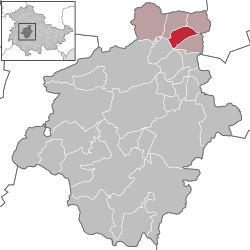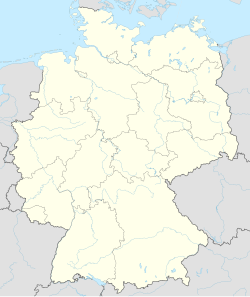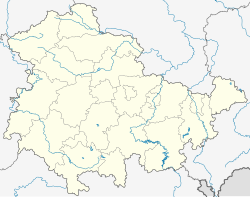Großfahner
Großfahner | |
|---|---|
Location of Großfahner
within Gotha district  | |
 | |
| Location of Großfahner | |
| Coordinates: 51°4′N 10°49′E / 51.067°N 10.817°E | |
| Country | Germany |
| State | Thuringia |
| District | Gotha |
| Municipal assoc. | Fahner Höhe |
| Government | |
| • Mayor (2022–28) | Martin Pennewiss[1] |
| Area | |
• Total | 11.41 km2 (4.41 sq mi) |
| Elevation | 200 m (660 ft) |
| Population (2023-12-31)[2] | |
• Total | 829 |
| • Density | 72.7/km2 (188/sq mi) |
| Time zone | UTC+01:00 (CET) |
| • Summer (DST) | UTC+02:00 (CEST) |
| Postal codes | 99100 |
| Dialling codes | 036206 |
| Vehicle registration | GTH |
| Website | www.vg-fahner-hoehe.de |
Großfahner is a municipality in the district of Gotha, in Thuringia, Germany.
The town is known to music historians due to the 600 manuscripts from 1650-1750 copied by the church music director of the period - these include cantatas from forgotten Kleinmeistern such as Buttstedt, Friedrich Erhard Niedt, "Liebhold," Georg Friedrich Künstel and Johann Topf, as well as the only surviving copies of works by masters such as Pachelbel and Telemann.
References
[edit]- ^ Gewählte Bürgermeister - aktuelle Landesübersicht, Freistaat Thüringen, accessed 10 November 2022.
- ^ "Alle politisch selbständigen Gemeinden mit ausgewählten Merkmalen am 31.12.2023" (in German). Federal Statistical Office of Germany. 28 October 2024. Retrieved 16 November 2024.



